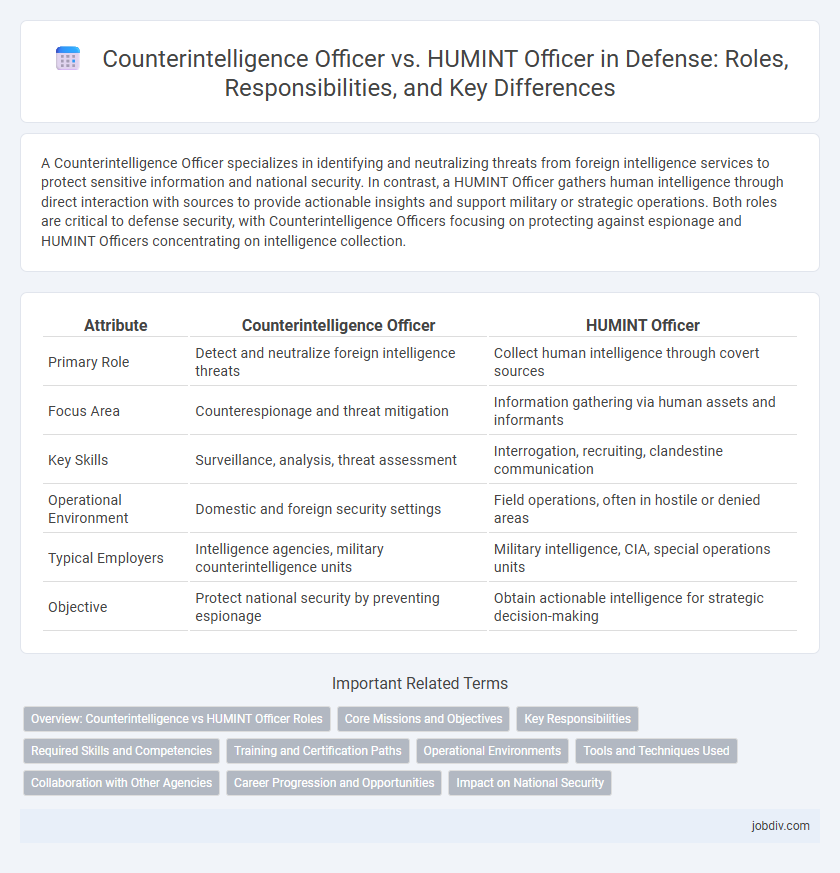A Counterintelligence Officer specializes in identifying and neutralizing threats from foreign intelligence services to protect sensitive information and national security. In contrast, a HUMINT Officer gathers human intelligence through direct interaction with sources to provide actionable insights and support military or strategic operations. Both roles are critical to defense security, with Counterintelligence Officers focusing on protecting against espionage and HUMINT Officers concentrating on intelligence collection.
Table of Comparison
| Attribute | Counterintelligence Officer | HUMINT Officer |
|---|---|---|
| Primary Role | Detect and neutralize foreign intelligence threats | Collect human intelligence through covert sources |
| Focus Area | Counterespionage and threat mitigation | Information gathering via human assets and informants |
| Key Skills | Surveillance, analysis, threat assessment | Interrogation, recruiting, clandestine communication |
| Operational Environment | Domestic and foreign security settings | Field operations, often in hostile or denied areas |
| Typical Employers | Intelligence agencies, military counterintelligence units | Military intelligence, CIA, special operations units |
| Objective | Protect national security by preventing espionage | Obtain actionable intelligence for strategic decision-making |
Overview: Counterintelligence vs HUMINT Officer Roles
Counterintelligence Officers focus on identifying, preventing, and neutralizing espionage, sabotage, and insider threats to protect military and national security assets. HUMINT Officers specialize in collecting human intelligence through interrogation, covert operations, and liaison with foreign sources to provide actionable intelligence. Both roles are critical for defense, but Counterintelligence emphasizes threat mitigation while HUMINT prioritizes intelligence gathering.
Core Missions and Objectives
Counterintelligence Officers primarily focus on identifying, preventing, and neutralizing threats posed by foreign intelligence services, safeguarding sensitive information and national security from espionage and infiltration. HUMINT Officers specialize in collecting human intelligence through direct interaction with foreign sources, conducting interviews, and managing informants to gather actionable intelligence. Both roles are critical for defense, with counterintelligence strengthening internal security and HUMINT providing vital external intelligence.
Key Responsibilities
Counterintelligence Officers specialize in identifying and neutralizing espionage threats, protecting sensitive information from foreign intelligence agencies, and conducting investigations to prevent insider threats. HUMINT (Human Intelligence) Officers focus on gathering intelligence through interpersonal interactions, managing sources, and conducting surveillance to collect actionable information. Both roles are critical for national security, with Counterintelligence prioritizing defense against espionage and HUMINT emphasizing intelligence collection from human sources.
Required Skills and Competencies
Counterintelligence Officers require advanced analytical skills, keen attention to detail, and expertise in identifying and neutralizing espionage threats to protect national security. HUMINT Officers must excel in interpersonal communication, cultural awareness, and covert operational planning to effectively collect human intelligence from sources. Both roles demand strong ethical judgment, adaptability, and proficiency in threat assessment methodologies to support defense objectives.
Training and Certification Paths
Counterintelligence Officers undergo rigorous training in threat analysis and covert operations, often requiring certifications such as the Certified Information Systems Security Professional (CISSP) or specialized counterintelligence credentials from agencies like the Defense Counterintelligence and Security Agency (DCSA). HUMINT Officers focus on human intelligence collection and source handling, with training programs emphasizing interrogation methods, cultural awareness, and language skills, supplemented by certifications from the Defense Intelligence Agency (DIA) or related military intelligence schools. Both career paths demand continuous professional development to keep pace with evolving intelligence techniques and emerging global threats.
Operational Environments
Counterintelligence Officers predominantly operate in hostile or high-threat environments to detect and neutralize espionage, sabotage, and insider threats, utilizing covert surveillance and counter-surveillance techniques. HUMINT Officers specialize in gathering human intelligence through direct interaction with sources, adapting to diverse operational theatres including conflict zones, urban settings, and foreign territories. Both roles require acute situational awareness and cultural expertise, but Counterintelligence emphasizes protective measures while HUMINT prioritizes intelligence collection.
Tools and Techniques Used
Counterintelligence Officers utilize advanced surveillance technologies, electronic monitoring devices, and cybersecurity tools to detect and neutralize espionage threats, while employing deception operations and background investigations. HUMINT Officers prioritize human sources, relying on interpersonal skills, interrogation techniques, and covert communication methods to collect actionable intelligence from individuals. Both roles integrate signal intercepts and analytic software, but Counterintelligence emphasizes threat identification, whereas HUMINT focuses on information acquisition through human networks.
Collaboration with Other Agencies
Counterintelligence Officers and HUMINT Officers collaborate extensively with agencies such as the CIA, FBI, and NSA to enhance information sharing and threat analysis. Counterintelligence Officers focus on protecting national security by identifying and neutralizing foreign intelligence threats, while HUMINT Officers gather human intelligence through covert operations and interpersonal networks. Joint operations leverage their distinct expertise to provide comprehensive intelligence assessments and counter hostile activities effectively.
Career Progression and Opportunities
Counterintelligence Officers typically advance by specializing in detecting and neutralizing threats from foreign intelligence services, with career paths leading to senior roles in security analysis and strategic operations. HUMINT Officers build expertise in human sources and field operations, progressing to leadership positions in intelligence collection and covert mission planning. Both careers offer opportunities for interagency collaboration and advanced training, enhancing prospects in defense intelligence and national security sectors.
Impact on National Security
Counterintelligence Officers play a critical role in protecting national security by identifying and neutralizing foreign intelligence threats and insider risks, thereby preventing espionage and sabotage. HUMINT Officers gather human intelligence through covert operations and interpersonal contacts, providing actionable intelligence that informs strategic military and policy decisions. Together, their complementary functions enhance the defense community's ability to anticipate, mitigate, and respond to diverse security threats.
Counterintelligence Officer vs HUMINT Officer Infographic

 jobdiv.com
jobdiv.com